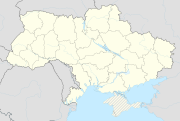Smila
| Smila | ||
| Сміла | ||

|
|
|
| Basic data | ||
|---|---|---|
| Oblast : | Cherkasy Oblast | |
| Rajon : | District-free city | |
| Height : | 73 m | |
| Area : | 39.80 km² | |
| Residents : | 68,384 (January 1, 2004) | |
| Population density : | 1,718 inhabitants per km² | |
| Postcodes : | 20700 | |
| Area code : | +380 4733 | |
| Geographic location : | 49 ° 13 ′ N , 31 ° 52 ′ E | |
| KOATUU : | 7110500000 | |
| Administrative structure : | 1 city , 1 village | |
| Mayor : | Andrij Kolesnyk | |
| Address: | вул. Леніна 37 37400 м. Сміла |
|
| Website : | http://city.smila.com | |
| Statistical information | ||
|
|
||
Smila ( Ukrainian Сміла ; Russian Смела Smela ) is an independent city in the central Ukrainian Cherkassy Oblast . It is located on the left bank of the Tjasmyn River and is the administrative seat of the Smila Rajon of the same name . The majority of Smila is inhabited by Ukrainians (2001: 89.6%), Russians (8.7%) make up the second largest ethnic group.
geography
Smila is located south of a more than 200 km² moor area called the Irdyner Swamp , which extends almost to the Kremenchuk reservoir and is drained by the Irdyn . On the eastern edge of the city is the White Lake, which has two inlets and the Tjasmyn as an outlet. The rivers Hnylyj Taschlyk and Sriblyanka flow into the Tyasmyn here.
history
The place was first mentioned in the 16th century and was initially part of Poland or the Ukrainian Cossack state . In 1773 Smila received Magdeburg city rights . After the city came to the Russian Empire in 1795, the city's industrial development began in the 1830s. Count Alexej Alexejewitsch Bobrinskoj (Russian Алексей Алексеевич Бобринской ), the grandson of Catherine II of Russia , who founded a sugar factory in 1838 and a mechanical workshop in 1840, played an important role . The economic development increased with the connection to the railway network in 1876. In the first half of the 20th century the development of the city was severely hampered by the two world wars and the famine of 1932 . Only after the reconstruction was Smila able to experience an upswing again. However, this changed with the collapse of the Soviet Union and the subsequent economic crisis. Industrial production fell by over 70% between 1990 and 2000. In parallel, Smila lost more than 10% of the population. Since 1996 the city has been twinned with the US city of Newton , Iowa and with Rzhev .
Economy and Transport
The economic focus is on mechanical engineering , the food industry is also important. Aluminum ore deposits are mined near the city . Smila is one of the most important railway hubs in Ukraine. The railway lines Kiev - Dnipro and Odessa - Russia / Belarus intersect in it .
sons and daughters of the town
- Juri Gempel (* 1957), lawyer and chairman of the Republican Community of Crimean Germans "Rebirth"
- Leonid Lytwynenko (* 1949), decathlete
- Vladimir Medinsky (* 1970), Russian politician and writer
- Leonid Portenko (1896–1972), Russian ornithologist and zoogeographer
- Grigori Schtern (1896–1972), Soviet Colonel General
- Adolf Spiwakowski (1891–1958), Russian singer
- Jascha Spiwakowski (1896–1970), Russian pianist



